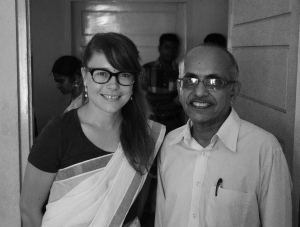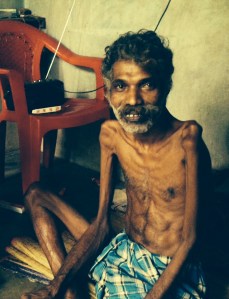After having spent a month in Kerala, experiencing first-hand the most developed palliative care services in India, I am now living and working in Kolkata in West Bengal. With a population of 14 million, 22% of people live below the poverty line (BPL) in Kolkata, which equates to Rs 27 per day or 27p per day. A large proportion of the population do not have the means to access even basic health care. With only a handful of outpatient palliative care clinics even fewer are lucky enough to access essential pain medication and palliative care services. I am currently working in the ‘Saroj Gupta Cancer Centre and Research Institute’, so all the patients I am working with have cancer. It is estimated that one million new cases of cancer occur each year in India, with over 80% presenting at the point at which the disease is incurable and/or has spread throughout the body, known as metastatic cancer. Around sixty percent will already be in significant pain and just under half will be experiencing excruciating, unbearable pain1. The need for palliative care in India is huge.
This initial blog is a factual account of what palliative care is and the situation in India. After setting the scene, future blogs will include more personal observations of the challenges faced including patient stories.
What is Palliative Care?
Palliative care is a philosophy of care and an expanding medical speciality that works to improve the quality of life of patients and their families facing the problems associated with life-threatening illness, ultimately giving patients an opportunity to have a dignified and pain free death. The World Health Organisation (WHO) definition states that this is achieved ‘through the prevention and relief of suffering by means of early identification and impeccable assessment and treatment of pain and other problems, physical, psychosocial and spiritual.’ In real terms, this means supporting patients and their families to cope better with physical symptoms associated with progressive disease such as pain or nausea, as well as providing essential emotional, social and spiritual support. With appropriate and often simple measures such as regular pain medications patients may be able to work for longer or carry on normal daily activities such as helping children with schooling, or attending social functions in the community. Allowing patients and families to talk about and prepare for death can help relatives cope with the loss. In India there is an opportunity to reduce the risk of families falling into crisis and becoming trapped in the cycle of poverty. I will elaborate more on some individual patient stories in future blogs.
A patient with a non-malignant illness
Historically, hospice and palliative care programmes focused on the needs of cancer patients who often had a high burden of symptoms. This is no longer the case as the majority of those needing palliative care worldwide suffer from non-malignant conditions including HIV, TB, end stage renal failure, heart failure and lung disease. Palliative care teams are increasingly becoming involved earlier in a patient’s journeys, as good symptom control and holistic care improves the quality of life of the patient irrespective of the number of years they have left to live. It is not simply care of the dying.
Although palliative care does not intend to hasten or postpone death, there is evidence that lung cancer patients receiving early palliative care experienced less depression, increased quality of life and survived 2.7 months longer than those receiving standard cancer care2.
Current situation
Palliative Care was introduced in India in the mid-1980s, approximately 20years after the founding of the modern hospice movement in the UK. Dame Cicely Saunders opened St. Christopher’s Hospice in London in 1967.
In India the coverage of palliative services is extremely patchy. The most developed services can be found in Kerala; a state that boasts one of the highest literacy rate and life expectancy in India.
Kerala
I spent a month at Arumana Hospital in Trivandrum and was lucky enough to spend time with Dr Rajagopal and his team. Despite the huge number of challenges faced in developing services in India, passionate, dedicated and caring individuals like Dr Rajagopal have achieved a huge amount for palliative care. 
Me & Dr Rajagopal, Arumana Hospital
Dr. Rajagopal is the director of Trivandrum Institute of Palliative Sciences and the flagship NGO Pallium India. He is one of the founders of Pain and Palliative Care Society in Calicut, which in 1996 became a WHO ‘Demonstration Project’ for the developing world. This grew into the present Institute of Palliative Medicine, which now has over 100 palliative care centres in Kerala, as well as several outside the state. Thanks to this initiative about 40% of the needy in Kerala receive palliative care compared to the national average of less than 1%.

Visiting patients at home in Kerala
In April 2008, the Keralan government announced a palliative care and pain policy; the first state to do so in India.
West Bengal
West Bengal is far behind Kerala in terms of palliative care services. The unmet need here is massive. West Bengal covers an area three quarters the size of England, and has almost double the population (91 million). As of 2008, the state had only a handful of outpatient clinics providing basic palliative care services. In response to this need, Dr Mitra (Consultant Oncologist in Brighton & Sussex) initiated a link between UK palliative care experts and the Saroj Gupta Cancer Centre & Research Institute (SGCCRI), Kolkata. In 2010 he founded a charity called ‘Eastern India Palliative Care’ (EIPC), with the aim of strategic implementation of palliative care throughout the region; establishing services and training both healthcare professionals and volunteers in palliative care. At a similar time SGCCRI opened a palliative care department. I am now working in this department, seeing patients as well as helping to deliver the training programme run by EIPC in the hospital.
Challenges faced
There are many obstacles faced in the development of palliative care in India. These include population density, poverty and geographical diversity; one model does not fit all, and each state will need to develop its own policies to fit the social and cultural background3. Morphine is basically contraband in India. It also happens to be one of the most effective and the cheapest painkillers, essential for palliative treatment. The administrative hurdles for an institute to gain a morphine licence are phenomenal. Many individuals including Dr Rajagopal and Dr Mitra have worked tirelessly for years to address the restrictive policies regarding opioid (morphine) prescription. More or this in a future blog.
In India, most patient care is disease-orientated, so palliative care introduces a new approach; that of patient and family-centered care. This is an approach that is ingrained in UK practice; all UK medical graduates are trained in it and it is the foundation of GP care. Patients in India also have different expectations of doctors, and do not always expect to be told their diagnosis. The most common situation is for families to hide a serious diagnosis from their loved one, desiring to shield them from the knowledge that they are dying. This obviously means the concept of patient confidentiality is very different. Again, more on this to come. Finally, limited national palliative care policy and lack of institutional interest in palliative care means that workforce recruitment, especially in West Bengal is a real challenge. Having said all this, there is a lot of positive work going on, and I will be sharing more of this over the next year.
References
- http://www.eipc.org.uk/about-us/
- Temel, J.S., et al., Early Palliative Care for Patients with Metastatic Non–Small-Cell Lung Cancer, N Engl J Med 2010; 363:733-742, August 19, 2010, /NEJMoa1000678
- D, Patel FP, and Shar, Palliative Care in India: Current Progress and Future Needs Indian J Palliat Care. 2012 Sep-Dec; 18(3): 149–154.

